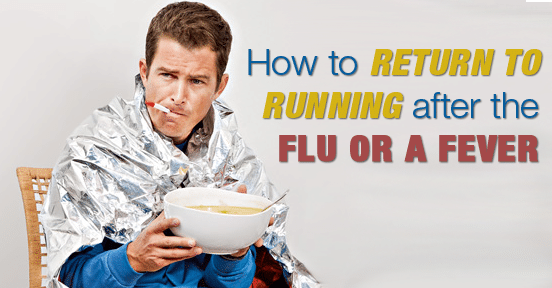A while back, we looked at some research on whether or not running while you have a mild illness, like a cold, has any detrimental effect on your recovery.
As it turns out, the research says no: moderate exercise, like easy running, has no impact on the duration or severity of symptoms from a mild upper-respiratory infection.
But what about more significant illnesses?
Obviously, you’re not going to get out and run normally when you’re laid up in bed with a fever and an unruly stomach, but what about after you’re over the worst of the flu?
Do you need to be more careful when returning to running, or can you you ramp back up to full training right away?

Returning to Running After Flu and Fever
There isn’t much direct research into this topic—although intentionally infecting willing volunteers with the common cold for the sake of research can pass muster with a university’s scientific ethics board, using influenza or another serious viral or bacterial infection treads into the ethically-questionable zone.
And given that more significant infections can take abrupt turns for the worse, it’s also not tenable to actively encourage people who’ve contracted these infections naturally to exercise for a scientific study.
What’s left is animal studies, along with observational papers and retrospective studies on the few hard-headed individuals (most often young men) who undertake vigorous exercise despite suffering from an infection.
Effects of exercise after being sick
The effects of exercise on the course of a significant viral or bacterial infection are unclear. The only study I could find which directly addressed this issue was a 2005 paper by three researchers at the University of Illinois at Urbana-Champaign and The Ohio State University.
This study looked at the impact of moderate exercise, prolonged exercise, or no exercise on the course of an influenza virus infection in mice. The mice were injected with influenza virus, then induced to exercise on a treadmill either for 20-30 min per day or 2.5 hours per day for the next four days.
The course of the viral infection was compared among the exercising mice and a control group which did no exercise. The severity and lethality of the influenza infection in the mice broadly mimicked the immune response seen in human athletes in other studies.
The moderately-exercising mice had improved survival rates and less severe infections when compared to the control group, while the mice who did prolonged exercise had a marginally lower survival rate and significantly worse symptoms.
Heat management
Another well-documented impact of infections is their ability to interfere with your body’s internal heat management.
A healthy athlete is astoundingly good at tolerating exercise even in oppressive heat: by increasing perceived fatigue, the brain is able to limit heat buildup in the body during a long session of exercise in hot weather, which usually makes running or racing in the heat a very safe, though perhaps unpleasant, proposition.
But when you’ve recently had a significant viral or bacterial infection, your risk for serious heat illness rises markedly.
A 2007 review of 994 cases of heat stroke hospitalization in the US Army concluded that “prior infection is a risk factor for heat illness,” and Tim Noakes cites other research which supports the same conclusion in his 2012 book, Waterlogged.
So, what should your plan be if you come down with a significant illness like the flu?
Doctors Göran Friman and Lars Wesslén of Uppsala University Hospital in Sweden authored a 2000 article which provided guidelines for exercise and illness in sick athletes.
- In the case of a fever over 100° F, Friman and Wesslén recommend complete rest until the fever subsides.
- They also recommend that athletes use caution in the first three days of an illness (even when fever is absent), because even quite significant infections can appear mild for the first day or two. Your takeaway – once completely better, run easy and short for at least 3 days
- Friman and Wesslén also advise being cautious with exercise in the week following a bacterial infection treated with antibiotics. Once your symptoms clear up, you should be cleared to ease back into training, but don’t jump into hard workouts or racing just yet. Your takeaway – wait at least a week before resuming hard workouts after a fever or the flu.
Takeaway message
Keep in mind, a recent illness predisposes you to developing heat illness, and fast running is by far the most significant causal factor for heat stroke in runners.
Even cool weather isn’t a guarantee of safety—Dr. William Roberts, the long-time medical director for the Twin Cities Marathon, reported a case of heatstroke in a well-trained marathoner on a cool 50° F day in Minneapolis.
The runner had suffered a viral infection in the days leading up to the race but decided to run anyways: the decision landed him in the hospital for five days with a core body temperature of over 105° F.
Don’t make the same mistake as him!
Do not do a hard, continuous run, or race until you’ve been fully recovered for at least a week from a significant viral or bacterial infection, especially if it included a fever.
RunnersConnect Bonus
Had to take some time off recently with an injury? Download our one-of-a-kind Performance Decline Calculator to find out what your estimated performance decline would be for any race distance.




One Response
The worst part is even after reading this I’m still going to perform my long run, lol.